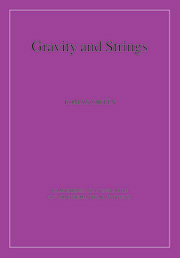Book contents
- Frontmatter
- Contents
- Preface
- Part I Introduction to gravity and supergravity
- Part II Gravitating point-particles
- Part III Gravitating extended objects of string theory
- 14 String theory
- 15 The string effective action and T duality
- 16 From eleven to four dimensions
- 17 The type-IIB superstring and type-II T duality
- 18 Extended objects
- 19 The extended objects of string theory
- 20 String black holes in four and five dimensions
- Appendix A Lie groups, symmetric spaces, and Yang–Mills fields
- Appendix B Gamma matrices and spinors
- Appendix C n-Spheres
- Appendix D Palatini's identity
- Appendix E Conformal rescalings
- Appendix F Connections and curvature components
- Appendix G The harmonic operator on ℝ3 × S1
- References
- Index
18 - Extended objects
Published online by Cambridge University Press: 20 February 2010
- Frontmatter
- Contents
- Preface
- Part I Introduction to gravity and supergravity
- Part II Gravitating point-particles
- Part III Gravitating extended objects of string theory
- 14 String theory
- 15 The string effective action and T duality
- 16 From eleven to four dimensions
- 17 The type-IIB superstring and type-II T duality
- 18 Extended objects
- 19 The extended objects of string theory
- 20 String black holes in four and five dimensions
- Appendix A Lie groups, symmetric spaces, and Yang–Mills fields
- Appendix B Gamma matrices and spinors
- Appendix C n-Spheres
- Appendix D Palatini's identity
- Appendix E Conformal rescalings
- Appendix F Connections and curvature components
- Appendix G The harmonic operator on ℝ3 × S1
- References
- Index
Summary
Introduction
In the previous chapters we have studied the upper-left- and upper-right-hand boxes of Figure 14.1 that concern the standard perturbative formulation of string theory and the effective actions of the ten-dimensional string theories (and M theory). We have also learned a bit about the existence of some non-perturbative states in the string spectrum, in particular D-branes and KK and winding modes in compactified theories (the lower-left-hand box of Figure 14.1). We have studied in the three cases the existence of dualities that related various theories and how these dualities are realized in the worldsheet action (when this is possible, i.e. for T duality) and in the effective actions. We have also mentioned that S dualities and T dualities imply the existence of new solitonic states in the string spectrum.
In this chapter and the next we are going to study systematically the lower-right-hand and central boxes of Figure 14.1, that is, the solitonic solutions of the string effective-field theories and their worldvolume actions. We will study the implications that the various dualities have for them (which are evidently related to the effects of dualities on the effective actions) and for the non-perturbative string spectrum. This chapter will be devoted to a general introduction to extended objects and in the next chapter we will deal specifically with those that occur in string/M theory.
These are subjects with many facets that are related in many ways to each other and to the subjects of the previous chapters. Therefore, it is hopeless to try to give a complete, or even half-complete, account of them in the space that we have at our disposal.
- Type
- Chapter
- Information
- Gravity and Strings , pp. 500 - 519Publisher: Cambridge University PressPrint publication year: 2004

